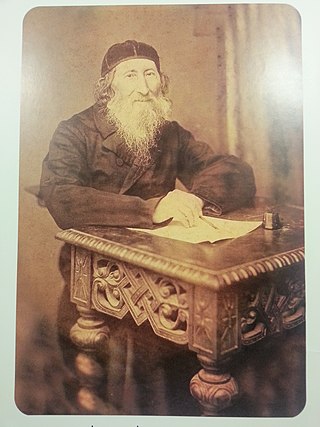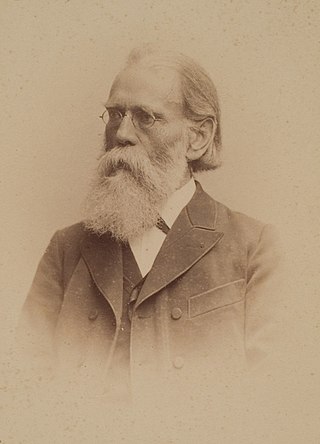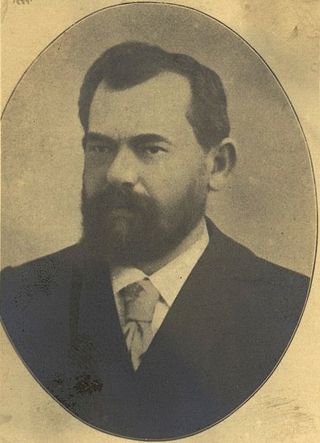This is a partial timeline of Zionism since the start of the 16th century.

Asher Zvi Hirsch Ginsberg, primarily known by his Hebrew name and pen name Ahad Ha'am, was a Hebrew journalist and essayist, and one of the foremost pre-state Zionist thinkers. He is known as the founder of cultural Zionism. With his vision of a Jewish "spiritual center" in Eretz Israel, his views regarding the purpose of a Jewish state contrasted with those of prominent figures within the Zionist movement such as Theodor Herzl, the founder of political Zionism. Unlike Herzl, Ahad Ha'am strived for "a Jewish state and not merely a state of Jews".

Leon Pinsker or Judah Leib Pinsker was a physician and Zionist activist.
The Lovers of Zion, also Hovevei Zion or Hibbat Zion, were a variety of proto-Zionist organizations founded in 1881 in response to the anti-Jewish pogroms in the Russian Empire and were officially constituted as a group at a conference led by Leon Pinsker in 1884.

Zvi (Zwi) Hirsch Kalischer was an Orthodox German rabbi who expressed views, from a religious perspective, in favour of the Jewish re-settlement of the Land of Israel, which predate Theodor Herzl and the Zionist movement. He was the grandfather of Salomon Kalischer.
The Odessa Committee, officially known as the Society for the Support of Jewish Farmers and Artisans in Syria and Palestine, was a charitable, pre-Zionist organization in the Russian Empire, which supported immigration to the Biblical Land of Israel, then a part of the Ottoman Empire.
The First Aliyah, also known as the agriculture Aliyah, was a major wave of Jewish immigration (aliyah) to Ottoman Palestine between 1881 and 1903. Jews who migrated in this wave came mostly from Eastern Europe and from Yemen, stimulated by pogroms and violence against the Jewish communities in those areas. An estimated 25,000 Jews immigrated. Many of the European Jewish immigrants during the late 19th-early 20th century period gave up after a few months and went back to their country of origin, often suffering from hunger and disease.

Samuel Mohilever, also Shmuel Mohilever, was a rabbi, pioneer of Religious Zionism and one of the founders of the Hovevei Zion movement.

Moshe Leib Lilienblum was a Jewish scholar and author. He also used the pseudonym Zelophehad Bar-Hushim. Lilienbloom was one of the leaders of the early Zionist movement Hovevei Zion.

Zvi Hermann Schapira, or Hermann Hirsch Schapira, was a Lithuanian rabbi, mathematician at the University of Heidelberg, and Zionist. He was the first to suggest founding a Jewish National Fund for the purchase of land in Palestine.
As an organized nationalist movement, Zionism is generally considered to have been founded by Theodor Herzl in 1897. However, the history of Zionism began earlier and is intertwined with Jewish history and Judaism. The organizations of Hovevei Zion, held as the forerunners of modern Zionist ideals, were responsible for the creation of 20 Jewish towns in Palestine between 1870 and 1897.

Rabbi Shimon Yaakov Halevi Gliksberg was a scholar, preacher, historian and one of the founding members of the Mizrachi Zionist movement.

Proto-Zionism is a concept in historiography describing Jewish thinkers active during the second half of the 19th century who were deeply affected by the idea of modern nationalism spreading in Europe at that time. They sought to establish a Jewish homeland in the Land of Israel. The central activity of these men took place between the years 1860 to 1874, before the establishment of practical Zionism (1881) and political Zionism (1896). It is for this reason that they are called precursors of Zionism, or proto-Zionists.

Natan Friedland was a Russian rabbi, writer, maggid, and proto-Zionist activist. A devotee of the 19th-century Hibbat Zion movement, he was instrumental, together with Zvi Hirsch Kalischer, in helping to lay the ideological groundwork for a movement to return the Jews to the Land of Israel in order to usher in the Messianic Age.
Samuel Pineles was a Jewish Romanian philanthropist and Religious Zionist activist. He was the driving force behind the 1881 Romanian Zionist meeting in Focșani. He was the president and secretary of the Central Committee to Settle the Land of Israel and Syria and was active in Hovevei Zion in Romania.

Yehudah Leib ha-Levi Levin, also known by the acronyms Yehalel and Yehalal, was a Hebrew socialist maskilic Hebrew poet, writer, and publicist. His poems were the first to introduce socialist themes into Hebrew literature.

Alter Druyanov was a Russian Jewish writer, editor, translator, folklorist, journalist, historian of early Zionism, and Zionist activist. His pen name derived from his birthplace, Druya, was variously transliterated as Druyanow, Drujanow, etc.) He wrote both in Yiddish and Hebrew languages.

Elḥanan Leib Lewinsky was a Hebrew-language writer and Zionist leader. His book Journey to the Land of Israel in the Year [5]800 is often described as the first work of science fiction in Hebrew.

Saul Pinchas Rabbinowicz was a Jewish scholar, writer and Hebrew translator, and a member of the Lovers of Zion movement.














